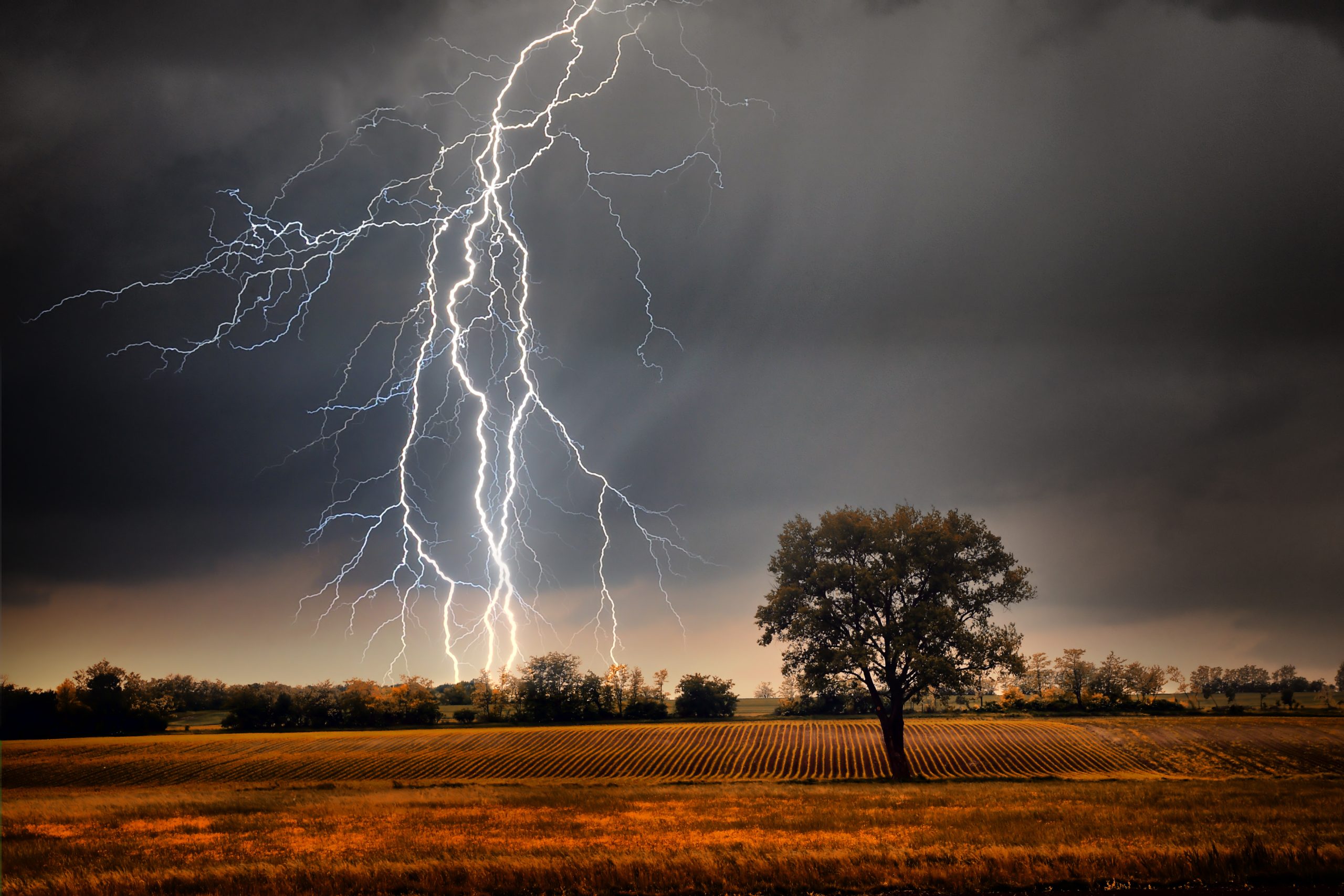Myths and facts about lightning and what to do if you’re caught in a storm.
Much of what is popularly believed about lightning and lightning safety is dangerously wrong. If you haven’t studied the subject recently, you might be surprised by the latest science and the fact that so many widespread beliefs have been discredited. And if you don’t know about phenomena such as “earth potential rise” and “upward streamers” (which, combined, account for about 60 percent of lightning-caused injuries and deaths), you might be putting yourself at serious risk, and not only while hunting.
Lightning begins inside tall cumulus clouds, as convective, roiling forces create distinct layers of negatively or positively charged electrical energy. When the oppositely charged fields build high enough, the normal insulating capacity of air breaks down and the fields connect in a sudden electromagnetic discharge, a massive spark, that we experience as lightning.
Most lightning remains inside the clouds (“intra-cloud” or IC flashes), without hitting ground. What concerns us are the cloud-to-ground (CG) strikes. CG lightning begins when an invisible “stepped leader” issues downward from a cloud. This usually is a very narrow channel of negative ions which zigzags its way in approximately 50-yard, multi-branched segments toward the ground. The intense negative charge elicits a positive-charge response from the earth, causing “streamer channels” to flow upward, especially through taller nearby objects (a tree, a mountainside, a person). When the oppositely charged leader and streamer meet, an electrical connection is made and a return stroke of intense luminosity zooms back to the cloud at about 60,000 miles per second. This is the flash we see, which is so quick we can’t properly perceive its direction. There might, in fact, be more than one return stroke and as many as 20 with a negative CG strike, accounting for the flickering appearance of some lightning.
When you hear thunder, there must be lightning, because lightning is what causes thunder. Energy from a lightning stroke heats surrounding air to more than 50,000 degrees F in a few millionths of a second, creating an explosive, audible shock wave. The loudest thunder is produced by cloud-to-ground flashes, and can be heard as far as 10 to 25 miles away. This has practical safety importance, because thunder is one of the keys to avoiding danger. Since light travels through air nearly a million times faster than sound, you can (sometimes) use the flash-to-bang formula to assess how close you are to approaching lightning. Count the seconds between an observed distant flash and the sound of thunder. Then divide that number by 5, since sound travels at about a fifth of a mile per second. If, for instance, the interval between lightning and thunder is 30 seconds, the flash was about 6 miles away. (This is dangerously close and means you are already in the risk zone.) Note that flash-to-bang isn’t always easy in the field. Multiple flashes can be hard to isolate and attach to a specific thunderclap. Even so, booms and rumbles in the distant sky are important to monitor, because they can help you apply the valuable “30-30 rule,” about which more later.
First, though, here’s a look at a very misunderstood subject: the various ways lightning can hurt you.
Direct Strike. As implied, this is when a bolt shoots down and hits a person straight on, usually because that person is out in the open. Contrary to general belief, direct strikes are comparatively uncommon in developed countries, comprising only 3 to 5 percent of fatalities.
Side Flash. (Also called “splash.”) This type of strike is much more frequent, causing about 30 percent of deaths and injuries. It occurs when lightning hits another object, such as a (comparatively) tall or lone tree, travels downward, and then “jumps” to a nearby human who is unwisely seeking shelter during a thunderstorm. Side flash can also occur person to person. If three people are hunkering under a struck tree, lightning can splash onto the nearest or tallest person, and then to the next one and the next, harming all.
Contact Injury occurs when someone touches a conductive surface that has been lightning-struck. It could be a metal fence or vehicle, or indoors, a sink faucet after a nearby strike has entered the ground and gone into the dwelling’s water-pipe system. Contact strikes account for about 3 to 5% of lightning injuries.
Earth Potential Rise (EPR). This term utilizes the physics concept of “potential energy,” and refers to what happens when lightning injects its current into the earth, greatly raising its “potential,” or voltage. Lightning might hit near someone and initiate a ground current that enters the body upward through the feet. There are many cases where multiple victims–for instance, a field of athletic players–are all felled by the same branching current. Another version of EPR occurs when a house is directly or indirectly hit and someone is using an ungrounded land-line telephone. The shock is often serious, resulting in disabling long-term medical issues. (Cordless phones are safe. Contrary to myth, so are cell phones, which do not attract lightning, or raise one’s risk of being struck, indoors or out.)
For hunters and other outdoor recreationists, a specific example of EPR is particularly important, and explains why it is not safe to seek shelter from a thunderstorm in a side-slope cave or beneath a rock overhang. When lightning strikes a mountain top or slope, the spreading current can discharge in a surface arc that travels downhill (especially if highly conductive rain is also draining downward). When the arc enters the cave or underhang area, it can create a sustained electrical field capable of causing serious burns, temporary paralysis. or death.
Upward Streamers. These are a serious but widely unknown source of danger. They occur when the ground sends an oppositely charged leader up toward a cloud’s descending step-leader, as described earlier. The up-rush of electrical energy can cause serious injury or death when a person becomes the unwitting conduit. (Hence one can be harmed by lightning without ever actually being “struck” by it.) Some medical authorities rank “streamer shock” as the most underestimated mechanism of [all] lightning injury.
Shock waves and blunt trauma. Finally, lightning can injure or kill “nonelectrically” from concussive shock waves and shrapnel injuries (as when tree bark or even concrete “explodes” after being struck) or when a person is thrown–sometimes tens of yards– and lands with blunt force trauma. In less-developed countries, especially in Africa, lightning that strikes ungrounded dwellings with thatched roofs frequently causes multiple casualties and deaths from a resulting fire. Often, temporary paralysis of the lower limbs (a common result of being struck) prevents people from escaping a burning structure.
Considering these many ways of being hurt by lightning, it seems a wonder that anyone can survive at all. But the surprising fact, at least in developed countries, is that most do. In the U.S. the fatality rate of lightning strikes is less than 10 percent. This is possible because of the incredible speed of many strikes, which penetrate the human body only for a microsecond before the current arcs or “flashes over” the outside of the skin (sometimes blasting away the victim’s clothing, shoes, and socks as surface moisture and perspiration vaporize with explosive force). Despite general belief, lighting injuries rarely involve deep burns–only 20 percent of victims suffer any burns at all, most of which are superficial. Immediate deaths are usually from cardiac and/or respiratory arrest. For this reason, first-aid triage for multiple lightning victims is the reverse of usual field procedure. “Treat the dead victims first,” is the rule, since many can be revived with immediate CPR that includes rescue breaths. Note that a person who has been lightning-struck is not dangerous to touch nor brimming with transferable electricity (another myth).
After someone is hit by any form of lightning, burst eardrums are common, as are neurological disorders. “Surviving” a lightning strike in about 70 percent of cases means dealing with serious and lasting impairments. Memory loss, cognitive disability, personality changes, sleep disorders, stress syndromes, depression, job loss, chronic pain–these are only some of the many terrible aftereffects of being struck by lightning.
The idea, of course, is not to get struck in the first place, and the best way is through the right preventative measures. One approach is the 30-30 rule. The first 30 refers to the flash-to-bang formula described earlier. If the count between a flash of lightning and the sound of thunder is 30 seconds or less, you’re already in danger and should head for safe shelter. (Some experts say even this is cutting it too close and it’s better to simply heed the maxim, “when thunder roars, go indoors.”) The second 30 means: wait 30 minutes after a storm passes and the last lightning/thunder is seen or heard before going outdoors or resuming an outdoor activity. There are good reasons for the 30-30 rule. Many people are struck well before a storm actually arrives, or after they believe it has passed. Lightning can strike ten miles or more beyond the storm cell, ahead, to the side, or behind. It can even hit while you are standing under a clear blue sky, watching what you believe is a distant storm. “Bolts from the blue” really do happen. The common belief that it’s safe to stay outdoors, or in the open, until the rain arrives, is also dangerously wrong. Lightning often strikes well before the rain starts and well after the rain has stopped.
As it turns out, a lot of the advice we’ve been given on how to stay safe during a thunderstorm has been proven wrong. The much-touted “lightning crouch” (standing in a deep crouch, lowering your head to minimize being hit by an uncommon direct strike), has been denounced as ineffective, giving people a false sense of protection. The same for sitting on a rubber sleeping pad or backpack or wearing rubber-soled boots to stay safe from ground currents; it doesn’t work. Ditto for cautions not to hold or wear anything metal because metal attracts lightning. (Not true.) Or the suggestion to lie flat if you are caught in the open–a mistake, because that actually makes you more susceptible to ground currents.
Unfortunately, experts warn, there is no truly safe place outdoors during a lightning storm. To have total protection you either need to be inside a grounded building or shelter, or in a fully enclosed metalvehicle. A shack, camper, trailer (unless all metal), tent, or thatched hut (especially in Africa and Mexico) will not protect you from lightning strike, and may in fact increase your level of danger during a storm. Semi-open shelters such as those found along some mountain trails or in parks, on beaches, golf courses and at bus stops–or your home’s porch–can actually make you more vulnerable. If these places are struck directly or by side-flash, a very dangerous electrical-field arc can be created, similar to that described for caves and rock underhangs, and you do not want to be the “conductor” caught in the middle.
Inside a grounded dwelling during a thunderstorm, don’t touch anything conductive that connects to the outside of the building. This includes metal storm doors or window frames, plumbing, attached-receiver landline phones, etc. As for metal vehicles, these will function as a “Faraday Cage,” which takes an intense electrical lightning stroke on an upper surface (roof, hood) and conducts the current down the sides to the ground, protecting those inside. It’s a myth that rubber tires ground a vehicle. They don’t; in fact, tires often explode when socked by the voltage. The vehicle’s roof and exterior must be all metal (no fiberglass, or cloth convertible-top) and must be fully enclosed. It’s also important not to be touching anything that’s part of, or connects conductively to, the exterior or the electrical system.
Of course, while out hunting or hiking, it’s not always possible to get to one of these truly safe shelters before a storm is upon you. What to do then?
First, try not to be caught, by paying attention to local thunderstorm reports on your various media devices, by observing incoming weather and by heeding distant flashes and thunder-rumblings in the sky. Head for safety immediately at the first roar of thunder if you can. But if that’s impossible, there are some things you can do, and not do, to improve your odds. Stay out of the open. Don’t be the tallest object in the vicinity, and don’t be near or beneath the tallest object(s). Don’t assume a nearby ridge or mountain slope or stand of tall trees will provide a protection zone. That’s another myth, as is the belief that the tallest object in an area will always be the first hit. Not true. Lightning’s leader channel is a mere 1 to 3 inches in diameter–surprisingly narrow–and it can sense upstreaming ground-leaders only within a zone of less than 168 feet. A stand of trees or a mountain slope 200 feet away won’t matter if a leader-branch senses and connects with you first. This is also why you should not stand in a clearing between trees in a forest, as is sometimes advised.
When a thunderstorm approaches, stay off of ridges. Realize that storms and lightning are up to 5 times more prevalent in mountainous high country than down low, especially in the mid-to-northern Rockies. If caught in the heights, try to descend via gullies and drainage cuts, not along ridgelines or side-slope spines. Descend on the lee side (opposite of the incoming storm) if feasible. Seek refuge in low, rolling terrain or in an even-height stand of vegetation that is not, in itself, the tallest composite object in the vicinity. In a group of two or more people, spread at least twenty yards apart to avoid potential multiple-casualties and so that in case of a strike, the unhurt person(s) can lend first aid and call for help. Stay off of open water and away from tree lines at the edge of shores or meadows.
Finally, take lightning seriously as a threat whenever a thunderstorm is near, whether while hunting or at home. Nobody thinks they’ll be the rare unlucky person who gets hit by a bolt from above–until it’s too late, and in a literal flash, they are.












